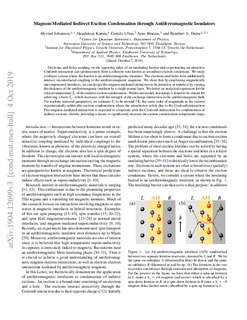| dc.contributor.author | Johansen, Øyvind | |
| dc.contributor.author | Kamra, Akashdeep | |
| dc.contributor.author | Ulloa, Camilo | |
| dc.contributor.author | Brataas, Arne | |
| dc.contributor.author | Duine, Rembert | |
| dc.date.accessioned | 2019-10-24T08:34:33Z | |
| dc.date.available | 2019-10-24T08:34:33Z | |
| dc.date.created | 2019-10-18T16:38:41Z | |
| dc.date.issued | 2019 | |
| dc.identifier.citation | Physical Review Letters. 2019, 123 (16), . | nb_NO |
| dc.identifier.issn | 0031-9007 | |
| dc.identifier.uri | http://hdl.handle.net/11250/2624070 | |
| dc.description.abstract | Electrons and holes residing on the opposing sides of an insulating barrier and experiencing an attractive Coulomb interaction can spontaneously form a coherent state known as an indirect exciton condensate. We study a trilayer system where the barrier is an antiferromagnetic insulator. The electrons and holes here additionally interact via interfacial coupling to the antiferromagnetic magnons. We show that by employing magnetically uncompensated interfaces, we can design the magnon-mediated interaction to be attractive or repulsive by varying the thickness of the antiferromagnetic insulator by a single atomic layer. We derive an analytical expression for the critical temperature Tc of the indirect exciton condensation. Within our model, anisotropy is found to be crucial for achieving a finite Tc, which increases with the strength of the exchange interaction in the antiferromagnetic bulk. For realistic material parameters, we estimate Tc to be around 7 K, the same order of magnitude as the current experimentally achievable exciton condensation where the attraction is solely due to the Coulomb interaction. The magnon-mediated interaction is expected to cooperate with the Coulomb interaction for condensation of indirect excitons, thereby providing a means to significantly increase the exciton condensation temperature range. | nb_NO |
| dc.language.iso | eng | nb_NO |
| dc.publisher | American Physical Society | nb_NO |
| dc.title | Magnon-Mediated Indirect Exciton Condensation through Antiferromagnetic Insulators | nb_NO |
| dc.type | Journal article | nb_NO |
| dc.type | Peer reviewed | nb_NO |
| dc.description.version | acceptedVersion | nb_NO |
| dc.source.pagenumber | 7 | nb_NO |
| dc.source.volume | 123 | nb_NO |
| dc.source.journal | Physical Review Letters | nb_NO |
| dc.source.issue | 16 | nb_NO |
| dc.identifier.doi | 10.1103/PhysRevLett.123.167203 | |
| dc.identifier.cristin | 1738549 | |
| dc.relation.project | Norges forskningsråd: 262633 | nb_NO |
| dc.relation.project | Norges forskningsråd: 239926 | nb_NO |
| dc.relation.project | EC/H2020/669442 | nb_NO |
| dc.description.localcode | © American Physical Society 2019. This is the authors accepted and refereed manuscript to the article. | nb_NO |
| cristin.unitcode | 194,66,20,0 | |
| cristin.unitname | Institutt for fysikk | |
| cristin.ispublished | true | |
| cristin.fulltext | postprint | |
| cristin.qualitycode | 2 | |
